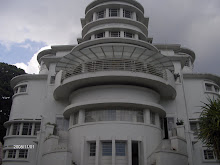Periods of English Literature
By: Susi Fitria
(0807334)
Class B
The Old English or Anglo-Saxon Period (5th-11th century)
It is the earliest period of English Literature. It is regarded as beginning with the invasion of Anglo-Saxon tribes in the 5th century AD till the French invasion under William the Conqueror in 1066. But however, the true beginnings of literature in England are to be found in The Latin Middle Ages, when monasteries were the main institutions that preserved classical culture.
Among the most important Latin literary text is the Ecclesiastical History of the English People (Beda Venerabilis-731). Another well-known text in this period are “The Seafarer” (about 9th century), “The Wanderer” (about 9th-10 centuries), mythological Beowulf (about 8th century), or The Battle of Maldon (about 1000).
Middle English Period (12th-15th century)
In this period, occurred some rupture in culture and literature. A number of texts from various genres have been preserved. There is a long list of lyric poetry and epic with religious contents such as Piers Plowman (about 1367-70), which has been attributed to William Langland. And there is also a new genre of secular kind which is developed in this period; romance. This genre includes Sir Gawain and the Green Knight (anonymous-14th century) and Le Morte d’Arthur (Thomas malory-1470). It’s indirectly influenced the development of the novel in the 18th century; Cantebury Tales (Geoffrey Chaucer-1387), Decamerone (Giovanni Boccaccio-about 1349-51)
The English Renaissance or the Early New English Period (16th-17th century)
This period is focused on the history of the language, and the Elizabethan Age (Queen Elizabeth I) or Jacobean age (King James), divisions based political rule. This period notably focus on the revival of classical genres, such as epic Faerie Queene (Edmund Spenser-1590; 1596), and the drama with William Shakespeare, Christopher Marlowe and other. Besides the adaption of drama and epic, the English Renaissance also produced independent prose genres, such as romance Euphues (John Lyly-1578) or Arcadia (Philip Sidney-1580). The outstanding literary work of this time was written by John Milton; Paradise Lost (1667) and Paradise Regained (1671).
Augustan Age/ Golden Age/ Neoclassical (18th century)
This period is regarded as independent epoch. In this period, classical literature and literary theory were adapted to suit contemporary culture. Many authors wrote translation, theoretical essays and literary texts in a variety of genres. This period is also became a time to distributed texts, including the development of the novel as a new genre which is marked by Robinson Crusoe (Daniel Defoe-1719), Tom Jones (Henry Fielding-1749), Tristam Shandy (Laurence Sterne-1767) and the introduction of newspaper and literary magazines such as The Taller (1709-11) and The Spectator (1711-14).
The English Romanticism Period (First half of 19th century)
The first edition of the Lyrical Ballads (William Wordsworth-1798) and Samuel Taylor Coleridge (1772-1834) is considered as the beginning of this period in which Nature and individual; emotional experience play an important role. The most important representatives of English Romanticism include William Blake (1757-1827), John Keats (1795-1821), Percy Bysshe Shelley (1797-1851).
Victorian Age (Second half of 19th century)
It is represented by Realism and Naturalism. In this period, England was famous for its dramas, including the works of George Bernard Shaw (1856-1950). Charles Dickens (1812-70), William M. Thackeray (1812-70), Charlotte (1816-55) and Emily Bronte (1818-48) and George Elliot (1819-80) are among the outstanding representatives of this era.
Modernism (First to Second World War)
It can be seen as a reaction to the Realist movements of the late 19th century. Modernism discovered innovative narrative techniques such as stream of-consciousness or structural forms such as collage and literary Cubism. The main works from this period are Ulysses (1922) and Finnegans Wake (1939) by James Joyce, Mrs Dalloway (1925) and To the Lighthouse (1972) by Virginia Woolf, Three Lives (Gertrude Stein-1909), The Waste land (T.S. Eliot-1922), and The sound and the Fury(William Faulkner-1929)
Postmodernism (1960 and 1970s)
In Postmodernism, modernist issue are taken up again and adapted in an academic or formalistic way. It develops approaches of Modernism and characterize by narrative techniques with multiple perspective, interwoven strands of plot and experiments in typography. Among the representatives works of this period are Lost in the Funhouse (John Barth-1926), The Crying of lot 49 (Thomas Phynchon-1966), Double or Nothing (Raymond Federman-1971), The French Lieutenant’s Woman (John Fowles-1969), and the drama Waiting for Godot (Samuel Beckett-1952) and Travesties (Tom Stoppards-1974).
Refference:
Klarer, M. 1998. An Introduction to Literary Studies. London: Routledge
Rabu, 30 September 2009
Langganan:
Posting Komentar (Atom)


Tidak ada komentar:
Posting Komentar